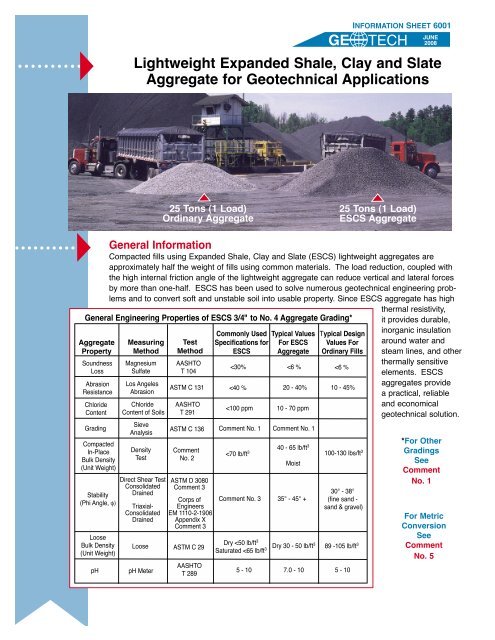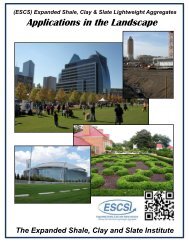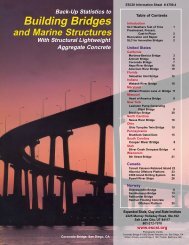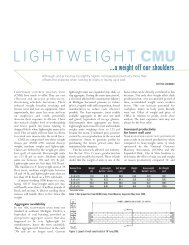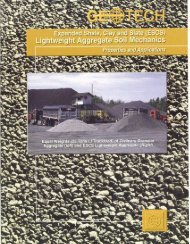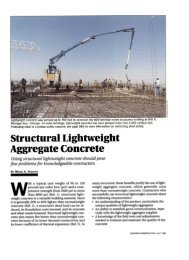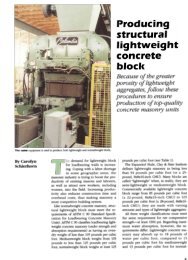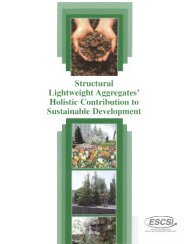Lightweight Expanded Shale, Clay and Slate Aggregate for ...
Lightweight Expanded Shale, Clay and Slate Aggregate for ...
Lightweight Expanded Shale, Clay and Slate Aggregate for ...
- No tags were found...
You also want an ePaper? Increase the reach of your titles
YUMPU automatically turns print PDFs into web optimized ePapers that Google loves.
INFORMATION SHEET 6001<br />
JUNE<br />
2008<br />
<strong>Lightweight</strong> <strong>Exp<strong>and</strong>ed</strong> <strong>Shale</strong>, <strong>Clay</strong> <strong>and</strong> <strong>Slate</strong><br />
<strong>Aggregate</strong> <strong>for</strong> Geotechnical Applications<br />
25 Tons (1 Load)<br />
Ordinary <strong>Aggregate</strong><br />
25 Tons (1 Load)<br />
ESCS <strong>Aggregate</strong><br />
<strong>Aggregate</strong><br />
Property<br />
General In<strong>for</strong>mation<br />
Compacted fills using <strong>Exp<strong>and</strong>ed</strong> <strong>Shale</strong>, <strong>Clay</strong> <strong>and</strong> <strong>Slate</strong> (ESCS) lightweight aggregates are<br />
approximately half the weight of fills using common materials. The load reduction, coupled with<br />
the high internal friction angle of the lightweight aggregate can reduce vertical <strong>and</strong> lateral <strong>for</strong>ces<br />
by more than one-half. ESCS has been used to solve numerous geotechnical engineering problems<br />
<strong>and</strong> to convert soft <strong>and</strong> unstable soil into usable property. Since ESCS aggregate has high<br />
General Engineering Properties of ESCS 3/4" to No. 4 <strong>Aggregate</strong> Grading*<br />
Soundness<br />
Loss<br />
Abrasion<br />
Resistance<br />
Chloride<br />
Content<br />
Grading<br />
Compacted<br />
In-Place<br />
Bulk Density<br />
(Unit Weight)<br />
Stability<br />
(Phi Angle, φ)<br />
Loose<br />
Bulk Density<br />
(Unit Weight)<br />
pH<br />
Measuring<br />
Method<br />
Magnesium<br />
Sulfate<br />
Los Angeles<br />
Abrasion<br />
Chloride<br />
Content of Soils<br />
Sieve<br />
Analysis<br />
Density<br />
Test<br />
Direct Shear Test<br />
Consolidated<br />
Drained<br />
Triaxial-<br />
Consolidated<br />
Drained<br />
Test<br />
Method<br />
AASHTO<br />
T 104<br />
Commonly Used<br />
Specifications <strong>for</strong><br />
ESCS<br />
Typical Values<br />
For ESCS<br />
<strong>Aggregate</strong><br />
Typical Design<br />
Values For<br />
Ordinary Fills<br />
Specifying ESCS Geotechnical Fill<br />
Consult your exp<strong>and</strong>ed shale, clay or slate producer, preferably during the conceptual design<br />
phase of a project, <strong>for</strong> precise in<strong>for</strong>mation on aggregate grading, bulk density (unit weight),<br />
in-place compacted density, friction angle, thermal conductivity, <strong>and</strong> placement method. The<br />
ESCS producer often has the ability to offer a variety of grading options. Use this versatility to<br />
specify the optimum material <strong>for</strong> any given application. As with ordinary aggregates, the engineering<br />
properties of ESCS vary depending on aggregate sources <strong>and</strong> grading.<br />
Guide Specifications <strong>for</strong> <strong>Lightweight</strong> Geotechnical Applications<br />
<strong>Aggregate</strong><br />
<strong>Lightweight</strong> aggregate shall be <strong>Exp<strong>and</strong>ed</strong> <strong>Shale</strong>, <strong>Clay</strong> or <strong>Slate</strong> (ESCS) produced by the rotary<br />
kiln process <strong>and</strong> meeting the requirements of ASTM C 330. <strong>Lightweight</strong> aggregate shall have<br />
a proven record of durability, <strong>and</strong> be non-corrosive, with the following properties:<br />
<strong>Aggregate</strong> Physical Properties<br />
A1 Soundness Loss: The maximum soundness loss shall be 30% when tested, with<br />
4 cycles of Magnesium sulfate, in accordance with AASHTO T 104.<br />
A2 Abrasion Resistance: The maximum abrasion loss shall be 40% when tested in<br />
accordance with ASTM C 131.<br />
A3 Chloride Content: The maximum chloride content shall be 100 ppm when tested in<br />
accordance with AASHTO T 291.<br />
A4 Grading: <strong>Aggregate</strong> grading comes in a wide variety of sizes <strong>and</strong> is specified<br />
based on per<strong>for</strong>mance needs. Grading shall be tested in accordance with<br />
ASTM 136. (See Comment No. 1)<br />
Project Per<strong>for</strong>mance Specification<br />
B1 In-place bulk density (unit weight ): The maximum in-place compacted moist<br />
density shall be _______ lbs/ft 3 when tested in accordance with the method specified<br />
by the engineer. (See Comment No. 2)<br />
B2 Stability (Phi angle, Φ): The minimum angle of internal friction Φ shall be<br />
_______ degrees when tested in accordance with the method specified by the<br />
engineer. (See Comment No. 3)<br />
Construction<br />
C1 Method of Construction: <strong>Lightweight</strong> fill shall be placed in uni<strong>for</strong>m layers. The actual lift<br />
thickness, <strong>and</strong> exact number of passes by equipment used will be determined by the<br />
engineer, depending on the project requirements (i.e., stability, compaction, density).<br />
In confined areas vibratory plate compaction equipment shall be used (5 hp to 20 hp)<br />
with a minimum of two passes in 6” lifts <strong>for</strong> a 5 hp plate <strong>and</strong> 12” lifts <strong>for</strong> a 20 hp plate.<br />
The contractor shall take all necessary precautions when working adjacent to the<br />
lightweight fill to ensure that the material is not over compacted. Construction<br />
equipment, other than <strong>for</strong> placement <strong>and</strong> compaction, shall not operate on the exposed<br />
lightweight fill.<br />
PAGE 2<br />
C2 <strong>Aggregate</strong> loose bulk density (unit weight): The maximum aggregate loose bulk<br />
density _______ shall be ______ lbs/ft 3 when tested in accordance<br />
with ASTM C 29. (See Comment No. 4)
Comments<br />
1. Grading: ESCS aggregates are available in a wide variety of grading, there<strong>for</strong>e it is<br />
essential the specifier contact the ESCS supplier <strong>for</strong> the gradings that are available<br />
in a given location. Some common gradings are 3/4" to No 4, 1/2" to No. 4,<br />
3/8" to No. 8, 3/8" to 0, 2" to 3/4", 2" to 0 or blends of these. ESCS aggregate<br />
suppliers can be found on ESCSI’s website at www.escsi.org.<br />
2. Several methods have been used to determine the in-place moist bulk density (unit weight)<br />
of a given aggregate, there<strong>for</strong>e contact the ESCS producer <strong>for</strong> recommendation on local<br />
practices. The following methods have proven per<strong>for</strong>mance:<br />
The lightweight aggregate producer shall submit verification of a compacted moist<br />
density of less than _______lb/ft 3 when measured by a one point proctor test<br />
conducted in accordance with a modified version of ASTM D 698 “St<strong>and</strong>ard Test<br />
Methods <strong>for</strong> Laboratory Compaction Characteristics of Soil Using St<strong>and</strong>ard Ef<strong>for</strong>t.”<br />
Because of the cohesionless nature of coarse lightweight aggregate, the st<strong>and</strong>ard shall<br />
be modified as follows: The aggregate sample shall be placed in a 0.5 cubic foot bucket<br />
at the moisture content that the aggregate will be delivered to the jobsite. The sample<br />
shall be placed in three equal layers <strong>and</strong> compacted by dropping a 5.5 pound rammer<br />
from a distance of 12 inches 25 times on each layer (AASHTO T-99 modified as above).<br />
3. ESCS <strong>Lightweight</strong> <strong>Aggregate</strong> has been tested by both Direct Shear <strong>and</strong> Triaxial test<br />
methods. With either method, the phi angle will vary in both ordinary <strong>and</strong> ESCS fill,<br />
depending on test procedure, aggregate grading, particle angularity, amount of compaction<br />
<strong>and</strong> amount of consolidating stress applied during the test. Design <strong>and</strong> specify the minimum<br />
phi angle appropriate <strong>for</strong> the project design <strong>and</strong> material(s) that are contemplated <strong>for</strong> use in<br />
the project. Contact the ESCS supplier(s) <strong>for</strong> specific properties of their materials.<br />
Direct Shear: The minimum angle of an internal friction shall be tested in<br />
accordance with ASTM D 3080 on a saturated representative sample (with particles<br />
larger than 0.75 inch removed) <strong>and</strong> tested in a round or square shear box that is a<br />
minimum of 12 inches across. Follow the procedure in D 3080 or shear the box at a<br />
rate of 0.01 inches per minute at normal loads of 250, 500 <strong>and</strong> 1,000 pounds per<br />
square foot.<br />
4. For quality control <strong>and</strong> shipment quantities, the purchaser <strong>and</strong> supplier should agree on a<br />
maximum delivered loose bulk density (unit weight).<br />
5. To convert bulk density (unit weight) in lb/ft 3 to metric kg/m 3 , multiply by 16. To convert<br />
inches (in) to millimeters (mm) multiply by 25.4.<br />
PAGE 3
REFERENCE DOCUMENTS<br />
ASTM Documents:<br />
C 29<br />
C 88<br />
C 131<br />
St<strong>and</strong>ard Test Method <strong>for</strong> Unit Weight <strong>and</strong> Voids in <strong>Aggregate</strong>.<br />
St<strong>and</strong>ard Test Method <strong>for</strong> Soundness of <strong>Aggregate</strong>s by Use of Sodium Sulfate or<br />
Magnesium Sulfate.<br />
St<strong>and</strong>ard Test Method <strong>for</strong> Resistance to Degradation of Small-Size Coarse <strong>Aggregate</strong>s<br />
by Abrasion <strong>and</strong> Impact in the Los Angeles Machine.<br />
C 136 St<strong>and</strong>ard Test Method <strong>for</strong> Sieve Analysis of Fine <strong>and</strong> Coarse <strong>Aggregate</strong>s<br />
C 330<br />
D 698<br />
St<strong>and</strong>ard Specification <strong>for</strong> <strong>Lightweight</strong> <strong>Aggregate</strong> <strong>for</strong> Structural Concrete.<br />
Test Method <strong>for</strong> Laboratory Compaction Characteristics of Soil Using St<strong>and</strong>ard Ef<strong>for</strong>t<br />
(12,400 ft.-lbf/ft 3 (600 kN-m/m 3 ).<br />
D 3080 St<strong>and</strong>ard Test Method <strong>for</strong> Direct Shear Test of Soils Under Consolidated Drained<br />
Conditions.<br />
D 4253 St<strong>and</strong>ard Test Method <strong>for</strong> Maximum Index Density <strong>and</strong> Unit Weight of Soils Using a<br />
Vibratory Table.<br />
D 4254 St<strong>and</strong>ard Test Method <strong>for</strong> Minimum Index Density <strong>and</strong> Unit Weight of Soils <strong>and</strong><br />
Calculation of Relative Density.<br />
AASHTO Documents:<br />
T 99-01 St<strong>and</strong>ard Method of Test <strong>for</strong> Moisture-Density Relations of Soils Using a 2.5-kg (5.5-lb)<br />
Rammer <strong>and</strong> a 305-mm (12-in) Drop<br />
T 104<br />
T 260<br />
T 288<br />
T 289<br />
T 291<br />
T 290<br />
St<strong>and</strong>ard Method of Test <strong>for</strong> Soundness of <strong>Aggregate</strong> by Use of Sodium Sulfate or<br />
Magnesium Sulfate<br />
St<strong>and</strong>ard Method of Test <strong>for</strong> Sampling <strong>and</strong> Testing <strong>for</strong> Chloride Ion in Concrete <strong>and</strong><br />
Concrete Raw Materials.<br />
St<strong>and</strong>ard Method of Test <strong>for</strong> Determining Minimum Laboratory Soil Resistivity.<br />
St<strong>and</strong>ard Method of Test <strong>for</strong> Determining pH of Soil <strong>for</strong> Use in Corrosion Testing<br />
St<strong>and</strong>ard Method of Test <strong>for</strong> Determining Water Soluble Chloride Ion Content in Soil<br />
St<strong>and</strong>ard Method of Test <strong>for</strong> Determining Water Soluble Sulfate Ion Content in Soil<br />
US Army Corps of Engineers Documents:<br />
Engineer Manual, EM 1110-2-1906 Laboratory Soils Testing. Appendix X, Consolidated<br />
Drained Triaxial Test<br />
Contact Your Material Supplier<br />
PAGE 4<br />
<strong>Exp<strong>and</strong>ed</strong> <strong>Shale</strong>, <strong>Clay</strong> <strong>and</strong> <strong>Slate</strong> Institute<br />
2225 Murray-Holladay Road, Suite 102, Salt Lake City, Utah 84117<br />
801-272-7070 • Fax 801-272-3377<br />
www.escsi.org • e-mail: info@escsi.org<br />
Revised June 2008


